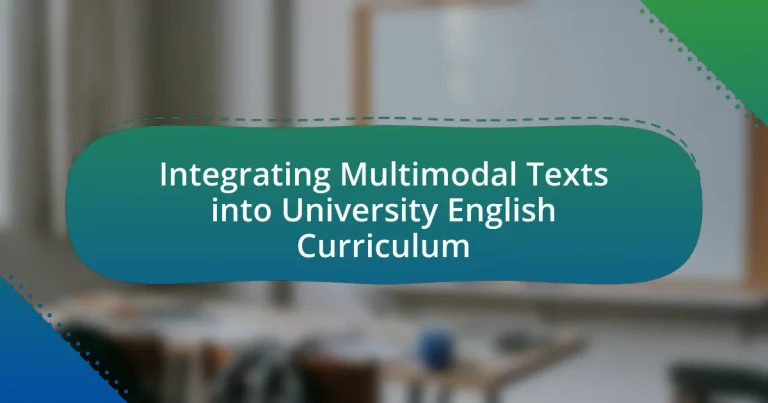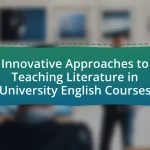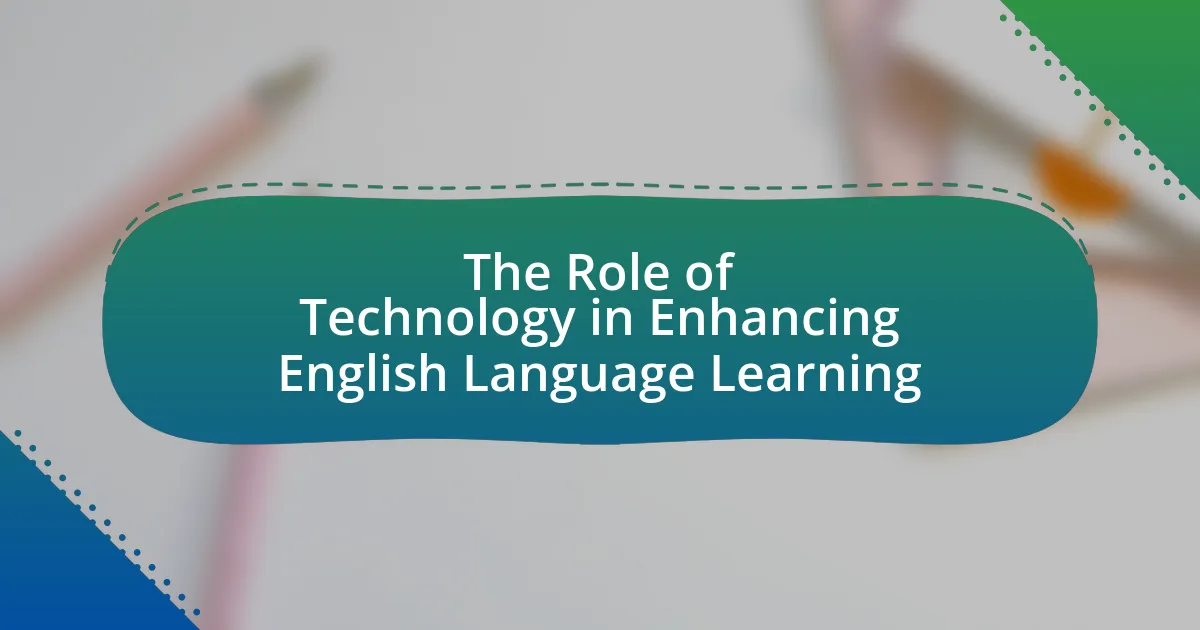The article focuses on the integration of multimodal texts into the university English curriculum, emphasizing their role in enhancing students’ critical thinking, engagement, and literacy skills. It outlines the differences between multimodal and traditional texts, highlighting the cognitive benefits of using diverse media formats, such as visual, auditory, and textual elements. The article also discusses effective strategies for educators to incorporate multimodal texts, the challenges they may face, and the positive feedback from students regarding their learning experiences. Additionally, it provides insights into best practices for utilizing multimodal resources to improve comprehension and retention in educational settings.

What are Multimodal Texts in the Context of University English Curriculum?
Multimodal texts in the context of the university English curriculum are materials that combine multiple modes of communication, such as written language, visual images, audio, and interactive elements, to convey meaning. These texts enhance students’ critical thinking and analytical skills by encouraging them to interpret and create content across various formats. Research indicates that integrating multimodal texts fosters deeper engagement and understanding, as evidenced by studies showing improved student performance and motivation when exposed to diverse media (Kress, 2010; New London Group, 1996).
How do Multimodal Texts differ from Traditional Texts?
Multimodal texts differ from traditional texts primarily in their use of multiple modes of communication, such as visual, auditory, and textual elements, whereas traditional texts typically rely solely on written language. This integration of various modes allows multimodal texts to convey meaning more dynamically and engage audiences through diverse sensory experiences. For example, a multimodal text may include images, videos, and sound alongside written content, enhancing comprehension and retention. Research indicates that students exposed to multimodal texts demonstrate improved critical thinking and engagement compared to those who engage only with traditional texts, highlighting the effectiveness of multimodal approaches in educational settings.
What elements constitute Multimodal Texts?
Multimodal texts consist of various elements including visual, auditory, and textual components. These elements work together to convey meaning and enhance communication. For instance, visual elements may include images, graphs, and videos, while auditory components can encompass spoken language, music, and sound effects. Textual elements involve written language, which can be presented in various formats such as print, digital text, or typography. The integration of these diverse elements allows for richer interpretation and engagement, as supported by research indicating that multimodal approaches improve comprehension and retention in educational settings.
Why is it important to understand these differences?
Understanding the differences in multimodal texts is crucial for effectively integrating them into the university English curriculum. These differences influence how students interpret, analyze, and engage with various forms of communication, such as visual, auditory, and textual elements. Research indicates that students who grasp these distinctions demonstrate improved critical thinking and analytical skills, as they can navigate complex information more adeptly. For instance, a study by Kress and van Leeuwen highlights that recognizing the unique affordances of different modes enhances comprehension and fosters a more holistic understanding of texts. Thus, understanding these differences is essential for developing students’ literacy in a diverse media landscape.
What role do Multimodal Texts play in enhancing learning?
Multimodal texts enhance learning by integrating various forms of communication, such as visual, auditory, and textual elements, which cater to diverse learning styles. This integration allows students to engage with content more deeply, facilitating better comprehension and retention of information. Research indicates that students exposed to multimodal resources demonstrate improved critical thinking and creativity, as these texts encourage them to analyze and synthesize information from multiple sources. For instance, a study by Kress and van Leeuwen (2001) highlights how multimodal literacy fosters a more holistic understanding of texts, thereby enriching the learning experience in educational settings.
How do they engage students differently than traditional texts?
Multimodal texts engage students differently than traditional texts by incorporating various forms of media, such as images, videos, and interactive elements, which enhance comprehension and retention. Research indicates that these diverse formats cater to different learning styles, making the material more accessible and stimulating for students. For instance, a study by Kress and van Leeuwen (2006) highlights that multimodal approaches can lead to deeper understanding and engagement, as they allow students to connect concepts through visual and auditory means, rather than relying solely on written language. This integration of multiple modes fosters active participation and critical thinking, setting it apart from the passive consumption often associated with traditional texts.
What cognitive benefits do Multimodal Texts provide?
Multimodal texts enhance cognitive benefits by engaging multiple senses and cognitive processes, which facilitates deeper understanding and retention of information. Research indicates that these texts improve critical thinking skills, as they require learners to analyze and synthesize information from various modes, such as visual, auditory, and textual elements. For instance, a study by Kress and van Leeuwen (2006) highlights that integrating visual and verbal information can lead to improved comprehension and memory retention, as learners are able to create more robust mental models. Additionally, multimodal texts promote creativity and problem-solving abilities by encouraging students to interpret and produce content across different formats, thereby fostering a more dynamic learning environment.
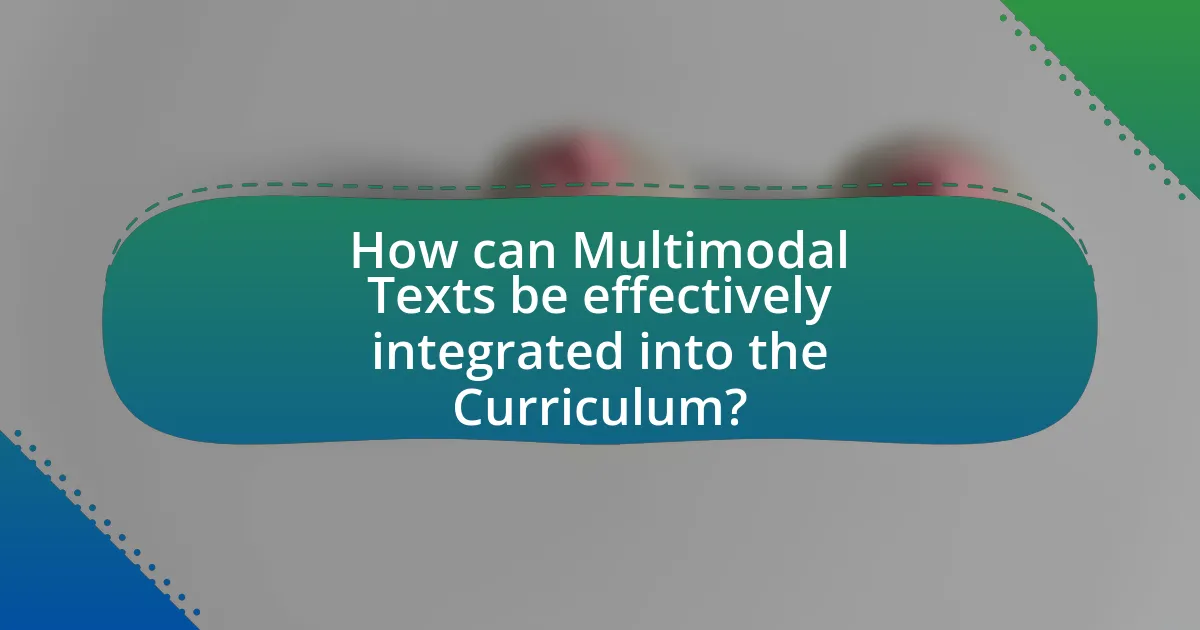
How can Multimodal Texts be effectively integrated into the Curriculum?
Multimodal texts can be effectively integrated into the curriculum by incorporating diverse media forms such as videos, podcasts, and infographics alongside traditional texts to enhance learning. This approach engages students by catering to various learning styles and promoting critical thinking skills. Research indicates that students who interact with multimodal texts demonstrate improved comprehension and retention, as evidenced by a study conducted by the University of Southern California, which found that students exposed to multimodal resources scored 20% higher on assessments compared to those using only traditional texts. By designing assignments that require analysis and creation of multimodal projects, educators can foster a deeper understanding of content while preparing students for real-world communication challenges.
What strategies can educators use for integration?
Educators can use collaborative learning, project-based learning, and technology integration as strategies for integrating multimodal texts into the university English curriculum. Collaborative learning encourages students to work together, fostering critical thinking and communication skills while engaging with diverse texts. Project-based learning allows students to explore real-world issues through multimodal texts, enhancing their understanding and application of concepts. Technology integration, such as using digital platforms and tools, facilitates access to various multimodal resources, making learning more interactive and relevant. Research by the National Council of Teachers of English highlights that these strategies improve student engagement and comprehension in multimodal literacy.
How can technology facilitate the use of Multimodal Texts?
Technology facilitates the use of multimodal texts by providing tools that enable the integration of various forms of media, such as text, images, audio, and video, into cohesive learning experiences. For instance, platforms like Google Slides and Prezi allow educators to create interactive presentations that combine these elements, enhancing student engagement and comprehension. Additionally, software such as Adobe Creative Suite enables the production of high-quality visual and audio content, which can be incorporated into assignments and projects. Research indicates that students exposed to multimodal texts demonstrate improved critical thinking and analytical skills, as they learn to interpret and synthesize information from diverse sources (Kress, 2010). Thus, technology not only supports the creation of multimodal texts but also enriches the educational experience by fostering deeper learning outcomes.
What types of assignments can incorporate Multimodal Texts?
Assignments that can incorporate multimodal texts include presentations, digital storytelling projects, research papers with visual components, and multimedia essays. These assignments allow students to engage with various forms of media, such as videos, infographics, and audio recordings, enhancing their understanding and expression of complex ideas. Research indicates that integrating multimodal texts in assignments can improve student engagement and learning outcomes, as evidenced by studies showing increased retention and comprehension when diverse media are utilized in educational settings.
What challenges might educators face when integrating Multimodal Texts?
Educators may face several challenges when integrating multimodal texts into the curriculum, including a lack of training in multimodal pedagogy. Many educators are accustomed to traditional text-based teaching methods and may struggle to effectively incorporate visual, auditory, and interactive elements. Additionally, there may be limited access to technology and resources necessary for implementing multimodal texts, which can hinder the learning experience. Furthermore, educators might encounter resistance from students who are not familiar with or do not appreciate multimodal approaches, leading to difficulties in engagement and comprehension. Research indicates that without proper support and resources, the integration of multimodal texts can result in uneven learning outcomes, as highlighted in studies on educational technology adoption.
How can resistance to change be addressed?
Resistance to change can be addressed by implementing effective communication strategies that involve stakeholders in the change process. Engaging faculty and students through workshops and discussions fosters understanding and reduces apprehension about integrating multimodal texts into the curriculum. Research indicates that organizations that prioritize transparent communication experience a 70% higher success rate in change initiatives, as highlighted in a study by Kotter International. This approach not only clarifies the benefits of the change but also allows for feedback, making individuals feel valued and more likely to embrace the transition.
What resources are available to support educators?
Various resources are available to support educators in integrating multimodal texts into the university English curriculum. These resources include academic journals such as “Computers and Composition,” which provides research on technology in education, and “The Journal of Multimodal Rhetorics,” focusing on multimodal communication. Additionally, organizations like the National Council of Teachers of English (NCTE) offer guidelines and professional development workshops that emphasize multimodal literacy. Online platforms such as the Digital Pedagogy Lab provide courses and materials specifically designed for educators to enhance their teaching practices with multimodal texts. These resources collectively equip educators with the necessary tools and knowledge to effectively incorporate multimodal elements into their curriculum.
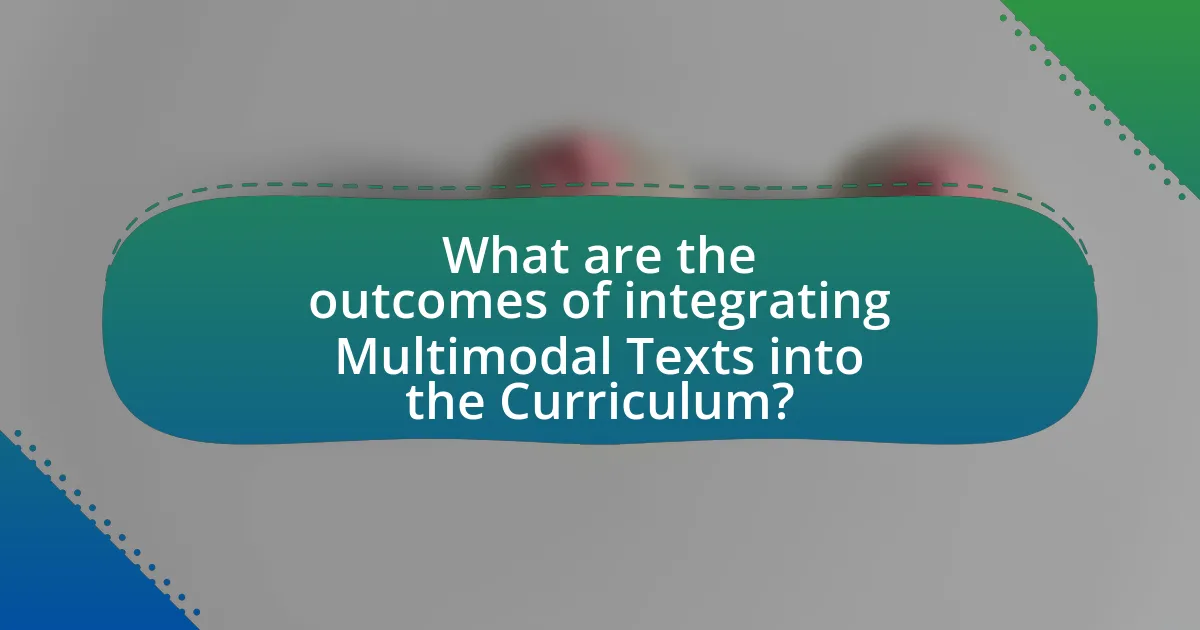
What are the outcomes of integrating Multimodal Texts into the Curriculum?
Integrating multimodal texts into the curriculum enhances students’ critical thinking, engagement, and literacy skills. Research indicates that exposure to diverse formats—such as visual, auditory, and digital media—promotes deeper understanding and retention of content. For instance, a study by Kress and van Leeuwen (2001) highlights that multimodal approaches facilitate the interpretation of complex ideas, allowing students to connect concepts across different media. Additionally, integrating these texts fosters collaboration and communication skills, as students often work in groups to analyze and create multimodal projects. This approach aligns with contemporary educational practices that emphasize the importance of preparing students for a multimedia-rich world.
How do students’ skills improve with Multimodal Texts?
Students’ skills improve with multimodal texts by enhancing their critical thinking, comprehension, and communication abilities. Multimodal texts, which combine various forms of media such as images, videos, and written content, engage students in diverse ways, fostering deeper understanding and retention of information. Research indicates that students exposed to multimodal learning environments demonstrate improved analytical skills, as they learn to interpret and synthesize information from multiple sources. For instance, a study by Kress and van Leeuwen (2006) highlights that integrating visual and textual elements in learning materials can lead to better engagement and a more nuanced understanding of complex concepts. This multifaceted approach not only aids in skill development but also prepares students for real-world communication scenarios where multiple modes of expression are prevalent.
What specific skills are enhanced through this integration?
The integration of multimodal texts into the university English curriculum enhances critical thinking, visual literacy, and collaborative skills. Critical thinking is improved as students analyze and interpret diverse forms of media, fostering deeper comprehension and evaluation of information. Visual literacy is developed through the ability to understand and create meaning from images, videos, and other non-textual elements, which is essential in a media-rich environment. Collaborative skills are enhanced as students engage in group projects that require them to communicate effectively and synthesize ideas from various modalities, preparing them for teamwork in professional settings.
How do Multimodal Texts prepare students for real-world applications?
Multimodal texts prepare students for real-world applications by enhancing their ability to interpret and create meaning across various formats, such as visual, auditory, and textual elements. This skill is crucial in a diverse media landscape where effective communication often requires integrating multiple modes of information. Research indicates that students exposed to multimodal learning environments demonstrate improved critical thinking and problem-solving skills, which are essential in professional settings. For instance, a study by Kress and van Leeuwen highlights that engaging with multimodal texts fosters adaptability and creativity, enabling students to navigate complex real-world scenarios effectively.
What feedback do students provide regarding Multimodal Texts?
Students provide positive feedback regarding multimodal texts, highlighting their engagement and enhanced understanding of content. Many students report that the combination of visual, auditory, and textual elements in multimodal texts facilitates deeper comprehension and retention of information. Research indicates that students feel more motivated and interested in learning when exposed to diverse formats, as these texts cater to various learning styles and preferences. For instance, a study by Kress and van Leeuwen (2001) emphasizes that multimodal approaches can significantly improve students’ critical thinking and analytical skills, reinforcing the effectiveness of integrating such texts into the university English curriculum.
How do students perceive their learning experience with Multimodal Texts?
Students generally perceive their learning experience with multimodal texts as engaging and beneficial for understanding complex concepts. Research indicates that multimodal texts, which combine visual, auditory, and textual elements, enhance comprehension and retention of information. For instance, a study by Kress and van Leeuwen (2006) highlights that students find these texts more relatable and stimulating, leading to increased motivation and participation in learning activities. Additionally, students report that multimodal texts facilitate diverse learning styles, allowing them to connect with the material in various ways, thus improving their overall educational experience.
What suggestions do students have for improving integration?
Students suggest enhancing integration by incorporating more diverse multimodal texts, such as videos, podcasts, and interactive digital content, into the curriculum. This approach allows for varied learning styles and engages students more effectively. Research indicates that using multimodal resources can improve comprehension and retention, as evidenced by a study published in the Journal of Educational Psychology, which found that students exposed to multimodal learning environments scored 20% higher on assessments compared to those in traditional settings. Additionally, students advocate for collaborative projects that encourage peer interaction and the sharing of different perspectives, further enriching the learning experience.
What best practices should educators follow when using Multimodal Texts?
Educators should prioritize the alignment of multimodal texts with learning objectives to enhance student engagement and comprehension. This involves selecting texts that complement the curriculum and facilitate critical thinking. Additionally, educators should encourage collaborative learning by having students analyze and create multimodal projects, fostering communication skills and creativity. Providing clear guidelines and scaffolding for assignments helps students navigate the complexities of multimodal texts effectively. Research indicates that integrating multimodal texts can improve literacy skills, as demonstrated in studies like “Multimodal Literacy: A New Approach to Teaching and Learning” by Cope and Kalantzis, which highlights the benefits of diverse text formats in educational settings.
